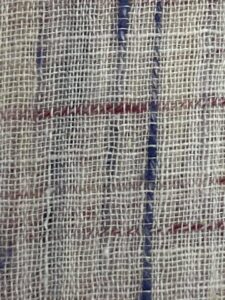This article focuses on one of the many ways to identify a hand woven textile from a machine made one
Text and Photographs : Savitha Suri
 One of the biggest, and perhaps most valid, concerns for buyers is on how to distinguish a hand woven textile from a machine woven one.
One of the biggest, and perhaps most valid, concerns for buyers is on how to distinguish a hand woven textile from a machine woven one.
While a Google search will throw up several results (not all of them reliable or well-articulated), what works best is the tactile experience of buying.
With machine made fabrics closely replicating hand woven ones, it has become very difficult to distinguish the two for laypersons.
What worked for me was a simple photograph – taken with a mobile phone camera. A close up of the weave will – more often than not- help identify.
 This naturally occurring ‘tension’ makes the fabric breathable and is also a reflection of the resilience of the yarn.
This naturally occurring ‘tension’ makes the fabric breathable and is also a reflection of the resilience of the yarn.
See the images closely and you will find that almost all hand woven fabrics ( especially cottons) will have (irregular) gaps that come from the natural ‘tension’ while weaving. In silks, the gaps will be closer because of the fine yarn used, but the gaps will be visible, especially at the borders. (Hand woven silks have a set of criteria of identification which deserves a separate post)
 This naturally occurring ‘tension’ makes the fabric breathable and is also a reflection of the resilience of the yarn. It simply means that the weaver has not exerted unnatural, external and unnecessary force while weaving, thereby allowing the yarn to retain its natural elasticity and strength.
This naturally occurring ‘tension’ makes the fabric breathable and is also a reflection of the resilience of the yarn. It simply means that the weaver has not exerted unnatural, external and unnecessary force while weaving, thereby allowing the yarn to retain its natural elasticity and strength.

See the machine woven fabric in the image and the difference is stark.
See the machine woven fabric in the image and the difference is stark. Do you see how tightly packed the fabric is? This comes from the even and tough pressure exerted by a machine.
Pricing of the respective fabrics is dependent on a number of factors such as quality of yarn, dyes, weaving, design and surface embellishment.
Hand woven products naturally cost more because of the human labour and time involved while machine made ones work on economies of scale making them appear as less expensive alternatives.
 This article focuses only on one of the many ways to identify a hand woven textile from a machine made one and is by no means the only way to do so.
This article focuses only on one of the many ways to identify a hand woven textile from a machine made one and is by no means the only way to do so.
You could try the method at home with different fabrics and see if you are able to identify the differences between them. It would be great if you could let us know what worked and what did not.
You could try the method at home with different fabrics and see if you are able to identify the differences between them.

Researching a textile thoroughly and assessing several vendors for integrity and authenticity are factors often sadly missed out on by buyers while buying handlooms, but remain the best way to invest in the rich and diverse hand- crafted textile traditions of the country.

